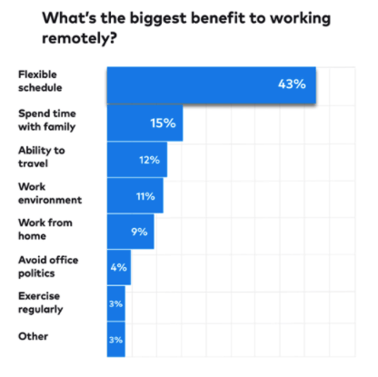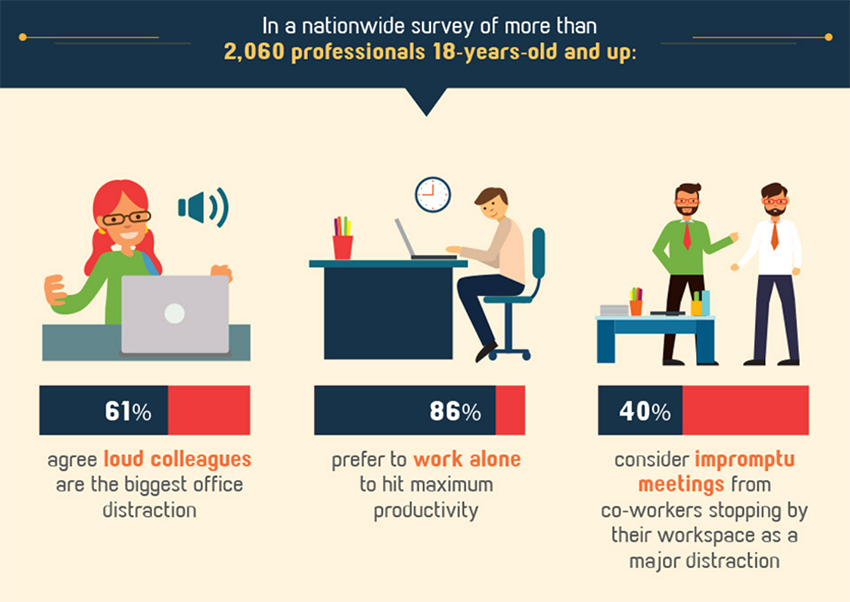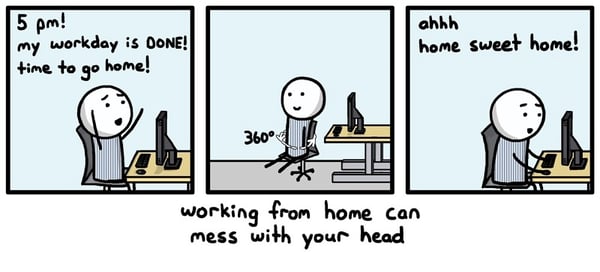Virtual Insanity: Rethinking The Traditional Workplace.

One of my senior leaders once told me a funny story about the time his kid was asked about what Dad did for work. “He talks on the phone in the basement all day,” the kid replied.
This pretty much sums up a lot of people’s perceptions about virtual work.
The optics of stuff like staying clad in business casual khakis and collared shirts (except for Fridays, which seems arbitrary, TBH), sitting in traffic and driving miles to go to a generic cubicle in a generic office to do what could instead get done in the aforementioned basement must be more important than productivity, engagement or retention.
That’s really the only conclusion you can draw from the fact that while it’s a widely growing trend and principal driving force behind the purported rise of the “gig economy,” virtual work remains just that in the eyes of far too many companies.
Working from home is, for whatever reason, often dismissed as a logical contradiction – despite reams of research suggesting that – just to scratch the surface, statistically speaking – virtual workers work over two hours a day longer than their office-based counterparts, were about 1/3 more likely to express job satisfaction and scored an average of just around 25% higher in their annual performance reviews than those required to face time for face-time.
Is Remote Work the Killer App?
Oh, yeah. A recent Stanford study also found offering work from home opportunities cut attrition rates in half (that’s right, a full 50% drop in annualized turnover) while 68% of currently employed job seekers – you know, the ones companies are apparently having a hard time hiring – say that they’d be more interested in considering specific opportunities if they offered virtual working arrangements.
It seems like any process improvement that simultaneously seems to reduce attrition (and the astronomical associated costs), makes hiring new workers easier and faster and saves companies a significant amount of committed capital expenses every year while making individual workers more productive would be a no brainer for businesses, particularly in today’s low margin, high competition marketplace.
You’d be wrong.

Virtual Reality and the New World of Work.
Instead, advocates of the “traditional workplace” tend to eschew quantitative evidence for more subjective, amorphous TA outcomes.
You know the ones.
They’re the kind of leaders who think unexpected “collisions” (effectively, these are, by definition, unsolicited work interruptions – yeah, this is an accepted theory, SMH) created by open office environments have more benefit than creating an environment conducive to working without having to worry about colliding with anyone at any time.
Or the kind of leader who wrongly assumes that showing how cool the physical space where employees are required to spend more time than their own homes is all that’s really required when building an employer brand, ignoring the fact that for an increasingly large segment of today’s workforce, the very concept of work is something you do, not somewhere you go.
Culture and proximity aren’t necessarily positively correlated, and as much as we’d like to believe that where work gets done matters in determining how (and how well) it gets done, there’s no evidence supporting either of these theories. In fact, the opposite seems to be true – 87% of virtual workers said that they felt “extremely connected” with their company and their colleagues.

Another assumption we should challenge is the notion that “traditional workplaces” are, in fact, traditional workplaces at all. In fact, the notion of having a distinct divide between work and home is actually a relatively modern invention.
No matter how blurred the line between those two worlds may seem sometimes, the fact that we accept that there exists some sort of assumed separation between the two is proof that the modern office in no way, shape or form represents a “traditional workplace” at all.
Traditionally speaking, my friends, work and home were traditionally interchangeable, assuming that the tenant farming, artisanal trade and agrarian labor could be considered “working from home,” even if it’s not exactly true, in the literal sense.
There was no flexibility, nor any expectation for it from the largely sustenance based workforce, who proved what Silicon Valley would later discover: people are willing to give up a big part of their lives for a little free food.
Of course, then automation happened – the first time. The Industrial Revolution lived up to its name, and the shift from small-scale agriculture to big time industry forced, for really the first time in the secular or civilian world, the need for separate, dedicated workspaces and a workforce willing, for really the first time, to “go” to work rather than just, you know, work.

And so it went, until for some reason, the very notion of virtual work or the concept of working from home was largely abandoned. For two centuries, work was very much a place, end of story.
In fact, it wasn’t until the 1970s that the whole idea of telecommuting even reentered our collective consciousness, which was a very Seventies thing to do, honestly.
But what started out as a relatively radical theoretical construct soon became an increasingly mainstream reality for many workers – or at least, a very real possibility.
Fully 50% of the US workforce today have jobs that could be done entirely through telework. Only 2.8%, however, take advantage of at least the possibility of working from home at least half of the time.
So what gives?
Studying Productivity Studies: The Business Case for Remote Work

If you’re looking for irrefutable evidence that remote workers are more productive than office-based employees, you don’t have to look hard.
There’s a ton of peer reviewed and immaculately researched studies which seem to comprehensively disprove the mistaken assumption that working from home is an obvious oxymoron.
Enjoy a sampling of this sampling:
- One popular study on the subject was performed by the founders of CTrip, a Chinese travel website. They allowed a portion of their call center staff to regularly work remotely for a nine month period. They found that their remote workers made 13.5% more calls than their office-bound counterparts, effectively putting in the equivalent of almost an entire extra day’s work.
- Another survey by TINYpulse found that remote workers were generally happier and felt more valued than their in-office counterparts. On the downside, they had lower relationship scores with their coworkers.
- Connect Solution found benefits for both employers and employees in cases where remote working was an option. 30% of workers accomplished a higher number of key objectives in less time when working off site, and 52% were less likely to take time off work, even when ill.
For workers, these same studies suggest the principal benefits, beyond
not having to commute, include better sleep, increased quality of life and an improved attitude towards their work and their companies – which are kind of the principal outcomes of even the most straightforward and simple employee engagement strategy.
The Drawbacks of Remote Work.

Of course, as they say on commercials, these results aren’t guaranteed simply because they work from home – many of these outcomes, of course, depend largely on the efforts and proclivities of these individual workers, the type of work and job related duties.
And yes, there are a ton of jobs (looking at you, healthcare) that require actually coming into work in order to get work done. Finally, the importance of face-to-face communication in building relationships and driving business eludes even the most sophisticated statistics.
While there are some studies suggesting that employees working independently and with limited contact are more productive, there’s also some evidence suggesting that the quality of that work is less consistent than those employees who work primarily from the office.
Furthermore, remote workers often report encountering obstacles, real or perceived, to collaboration and productivity as a result of their virtual work status. Of course, these can be largely overcome with clear policies and the right technologies in place to not only enhance visibility, but also, ensure individual accountability, too.
The End Result: Does Remote Work Really Work?
With clearly defined expectations and boundaries, remote workers can be more productive and beneficial than those in an office, but of course, whether or not virtual work is the right solution for your company largely depends on your situation and your expectations.
Furthermore, it also depends on your workers, too; certain age groups, like those crazy Millennials, and certain personality types or personal work styles are more inclined or predisposed to work effectively away from the office than others.

Make sure you understand the risks, as well as the rewards, before offering virtual work as a working option.
The overall benefits of remote work can far outweigh just increased employee satisfaction and improved employee engagement. From efficiencies such as decreased overheads and reduced carbon footprints (smaller offices mean lower rent) to significant spikes in worker retention, particularly among older workers who can stay in the workforce for longer, the new world of work is increasingly becoming a virtual reality.
For real.
Read more at TalentSpark from Allegis Global Solutions.
Spread the love:
- Click to share on Twitter (Opens in new window)
- Click to share on Facebook (Opens in new window)
- Click to email a link to a friend (Opens in new window)
- Click to share on Reddit (Opens in new window)
- Click to share on LinkedIn (Opens in new window)
- Click to share on Tumblr (Opens in new window)
- Click to share on Pinterest (Opens in new window)
Related
Category: recruiting, Technology Tags: company culture, employee engagement, hr technology, Recruiting, work life balance, world of work
We had a kid once visit the office years ago who was totally convinced we twirled around in our computer chairs throughout the day…. in reality – only sometimes. 😉
Seriously, remote work and virtual meetings are vital to our software technology company. Having a global presence I’m often in meetings with not only West Coast US (I’m East Coast,) but the UK, Hong Kong, Australia and Japan. Logistically and practically we couldn’t do it without virtual meetings. It helps to have the flexibility to work from home periodically, but is also important, as far as culture and camaraderie, to work in an office. Some people within the company do work solely at satellite offices from their homes, too. We have core groups in offices internationally, then make a point of convening regularly.
The key of course, is hiring those you can trust to get the work done from home, if you go that route. Sometimes, this can come as a reward after a year or two of demonstrated loyalty and hard work – the perk of being able to work from home a day or two.
Wanted to compliment you on a very well written piece. Am also very interested and we have built a unique platform that caters to this and a lot more. It actually connects the whole people chain and is designed for the future of work. Would be wonderful if I can invite you to check it out. Of course it’s free and the concept around it is Hire Right, Engage Right and Nurture right – go to http://www.peoplehum.com/#bl. Would be wonderful receiving feedback from someone like you.
Pingback: Virtual Insanity: Rethinking The Traditional Workplace. — Snark Attack – Lights Links Lagniappe
Remote working, flexible hours and even compressed time are all big turn-ons for jobhunters these days. I read somewhere recently that more than half of new candidates list the ability to work (at least some of the time) from home is a major factor when looking for a new job.
You don’t build a business. You invest in building your people and people build the business for you. Would welcome your thoughts on the Future of Work and how it is going to be – http://www.peoplehum.com/#bl – it is free and all we ask from you is your valuable feedback.
Remote Work is very useful especially for those having a hard time looking for job. And its very easy because you just have to work at home.
Great post! Thank you for the post.
Crew manning company in Mumbai
Great tech! Thank you for the post.
Thanks for sharing this articles.
How to increasing business traffic on you are website using Digital Marketing services. you get the more information so kindly Visit here:- https://www.zesfar.com
VR is at the Peak Stage every one needs the VR handset and a VR to enjoy the fullest.
I am a Businessman and I provide candidates to the managers. If someone needs a software developer, who can build a special new software for VR. You can contact me at any point in time. I provided candidates for other services too. kindly have a look on my website!
The data reveals where this problem may be more prevalent. Salaries and business culture can have an effect on attitudes to work, therefore businesses should consider how their employees are reacting to the pressures and conditions of the workplace and work to address those issues.
While sharing details on the most stressed states, the data also reveals which states are the least likely to experience stress and work-related burnout. Oklahoma achieved the status of the calmest state in the US. Oklahoma searched for the terms 26 percent less than the average state.
Arkansas and Montana followed as the next least-stressed states, searching for the terms 25 percent and 22 percent less than the average state.
Workplace burnout is an issue that all workers and employers should address. Reviewing salaries, the formality of a high-pressure environment, and even employee location should be considered by business leaders as contributing factors to stress. A productive workplace can be achieved with calm, happy, and comfortable staff. more on http://www.jobclass.in